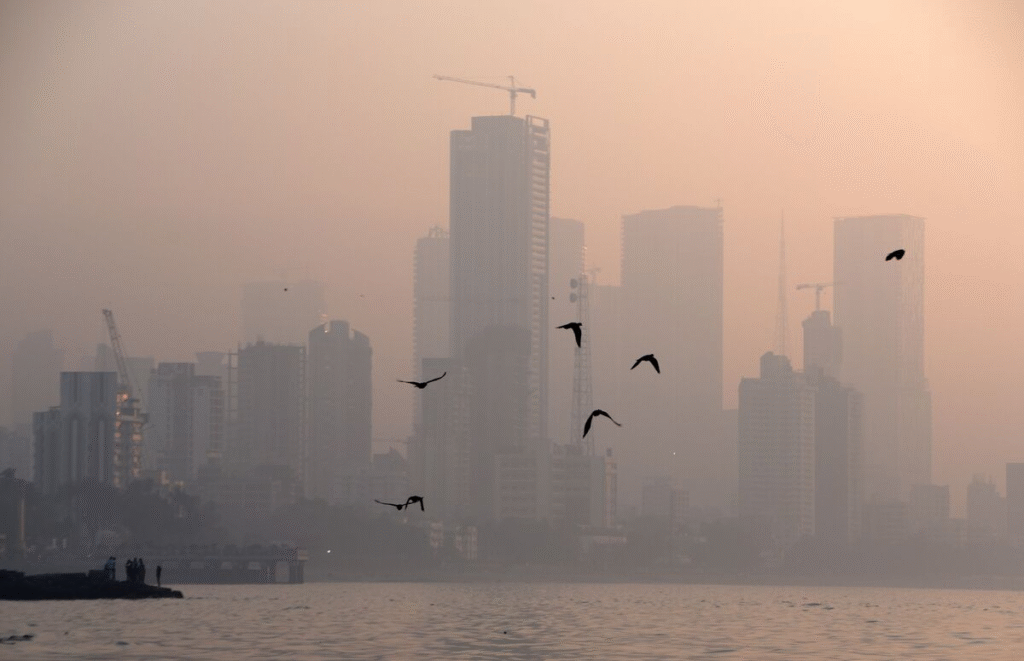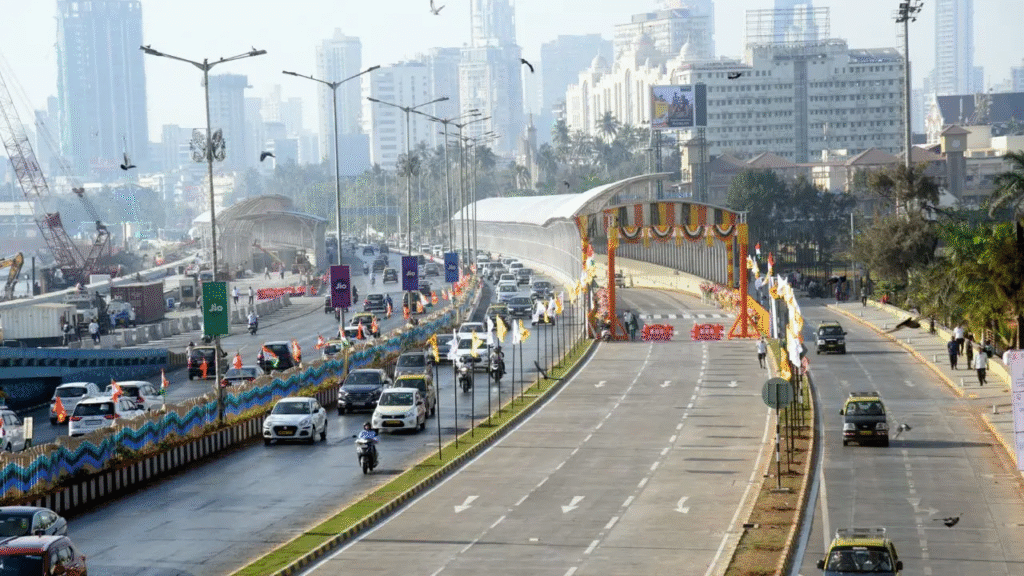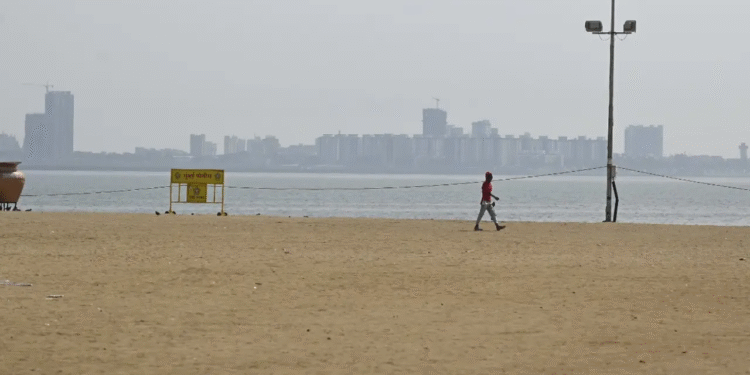Stay updated on Mumbai’s weather as the city experiences hot and humid conditions with air quality levels in the ‘moderate’ category. Learn what it means for your health, daily life, and what precautions to take
As the city of Mumbai braces through a lingering spell of hot and humid weather, the quality of the air is holding in the “Moderate” category — a reminder that while the monsoon has officially withdrawn, relief is yet to fully arrive.
According to the latest bulletin, residents of the metropolis are facing temperatures climbing to the low‑to‑mid 30s °C, with relative humidity remaining high, making the heat feel heavier than the numbers alone indicate. The forecast for today: hazy sunshine with maximum temperatures forecast around 33‑34 °C, and humidity persisting into the evening.
Currently 88° · Hazy sunshine
Mumbai, India

| 88° | Hazy sunshine | |
| 90° | Hazy sunshine | |
| 91° | Hazy sunshine | |
| 92° | Hazy sunshine | |
| 93° | Hazy sunshine | |
| 93° | Hazy sunshine | |
| 91° | Hazy sunshine | |
| 92° | Hazy sunshine | |
| Show more |
Meanwhile, air‑quality monitors show the city’s overall Air Quality Index (AQI) has remained in the “Moderate” category. At many monitoring stations, readings have ranged between ~130 and ~170, with certain pockets already seeing readings cross into the “Poor” category.
1. The Current Weather Situation
Hot with a Humid Edge

The departure of monsoon rains has left the city under a dry‑yet‑sticky spell. One report observed that although rainfall has largely ceased, humidity has hovered between 69 % and 78 % in recent days, even as temperatures soared above recent normals.
In more concrete terms, the India Meteorological Department (IMD) and other weather trackers note maximum temperatures pushing into the 34‑35 °C range in locales like Colaba and Santacruz, which are already about 1‑1.5 °C above expected averages for this time of year.
This combination of heat + humidity creates what climate experts sometimes call a “humid heat stress” scenario. Even though the temperature may seem manageable on paper, the high moisture content in the air reduces the body’s capacity to cool via evaporation (sweating), meaning the “felt” temperature can feel significantly higher.
Sky Haze & Reduced Wind
In addition to the climatic factors, meteorological conditions are favouring the accumulation of pollutants rather than their dispersion. A marked reduction in wind speeds, stable atmospheric layers, and the absence of recent substantial rainfall mean that emissions and dust are less easily removed from the air. This contributes to the persistent haze that many Mumbai residents have been noticing in the skyline.
All told, for residents and visitors alike the key experience these days is: hot afternoons, sticky nights, less breeze, and a skyline that often appears veiled by a light smog/haze layer.
2. Air Quality: Stuck in the ‘Moderate’ Zone, Some Areas Worse

What Does “Moderate” Mean?
In the commonly‑used AQI scale by the Central Pollution Control Board (CPCB) and others:
- 0‑50 = Good
- 51‑100 = Satisfactory
- 101‑200 = Moderate
- 201‑300 = Poor
- 301‑400 = Very Poor
- 401+ = Severe
Thus, when the city is registering readings in the 130‑170 range, it falls firmly into the “Moderate” category. And although “Moderate” may sound acceptable compared to “Poor” or “Very Poor”, it still means that sensitive individuals (people with respiratory or heart conditions, the elderly, children) may begin to experience discomfort.
Recent Readings and Trends
One recent analysis noted that on a particular day the AQI across Mumbai stood around 162, but with several monitoring stations already past the 200 mark (thereby slipping into “Poor”).
Another bullet‑point breakdown:
- On October 13, 2025, the AQI was ~135 in many locations, still in “Moderate”, but rising.
- The post‑monsoon dry/humid spell has been flagged as a driver for the worsening air quality.
- While much of Mumbai remains in “Moderate”, certain suburbs (especially in the east and north) have already crossed 200, signalling “Poor” air quality conditions locally.
Why the Deterioration?
Several inter‑linked factors contribute:
- Post‑monsoon scenario: After the monsoon withdrawal, there is less rainfall to cleanse the air and fewer strong winds; dust and emissions build up.
- High humidity + heat: As discussed, this reduces dispersion and can intensify formation of certain pollutants (ozone, fine particulates) under stagnant conditions.
- Urban emissions: Traffic congestion, construction dust, and industrial activities continue as usual, but the atmospheric conditions are less forgiving of dispersion.
- Geography and local micro‑climate: Being a coastal city, Mumbai sometimes benefits from sea breeze and humidity, but under dry/humid spells with weak wind, it can ironically trap pollutants close to the ground.
- Upcoming winter transition: Experts warn that the cleaner monsoon flow is gone, and the approach of winter with cooler nights, temperature inversion layers and lower wind speeds could make things worse unless emission sources are reduced.
3. Impacts on Residents & Daily Life
Health and Comfort
The combined effect of heat, humidity and moderate air pollution translates into several practical issues for the people of Mumbai:
- Physical discomfort: On sticky days, people feel sweaty even at milder temperatures because the high relative humidity prevents sweat evaporation. Outdoor chores or travel by auto/taxi feel more tiring.
- Sleep and night discomfort: With minimum temperatures remaining elevated and the humidity high, night‑time relief is limited. This can affect sleep quality and lead to tiredness the next day.
- Respiratory or cardiovascular strain: For those with asthma, COPD, sinus problems, or heart ailments, even “moderate” AQI means some risk. Symptoms such as wheezing, coughing, throat irritation or chest discomfort may increase.
- Outdoor activity caution: People may avoid vigorous physical activity outdoors in the afternoon, especially children, elderly or those with health issues.
- Visibility & aesthetics: The haze reduces clarity of the skyline or sea‑view; on some mornings, one may notice a blur over the sea‑link or harbour areas.
Effect on Lifestyle & Work
- Commuting stress: While vehicles may be moving, the heat inside autos, taxis and even crowded rail coaches feels more oppressive. Combined with the air quality, riders may feel more fatigued.
- Construction / road‑work slowdown: Workers outdoors are more prone to heat stress. Contractors may need to shift work schedules (early morning or evening) or plan additional breaks/hydration.
- Retail, tourism & outdoor events: Beach promenades, sea‐link views, promenades at Marine Drive etc may have fewer people in midday; cafes with reliable A/C may get preference. Tourists may prefer indoor sightseeing during peak heat hours.
- Energy‑use uptick: With hot, humid nights, households are likely to run fans, A/C or coolers longer, putting pressure on power supply, and perhaps increasing bills.
4. What to Expect Going Forward
Forecast & Trend
- The immediate forecast for Mumbai shows daytime highs around 33‑34 °C, with humidity continuing into the evening and night.
- Since rainfall is not imminent and wind remains light, these conditions may persist for several days.
- As the city transitions into its cooler season, there’s a risk that air quality may dip from “Moderate” into “Poor” unless mitigating steps are taken—especially if temperature inversions set in and wind remains calm.
Precautionary Advice
For residents, here are some proactive steps to maximise comfort and minimise health risk:
- Hydration is key: Drink plenty of water, especially if you are outdoors, walking or working.
- Avoid strenuous outdoor activity during peak sun/humidity hours (12 pm–4 pm). Prefer early morning or late evening for tasks/exercise outside.
- Use protective gear if needed: For those sensitive to air‑quality issues, carry a lightweight mask (PM2.5‑capable) or consider indoor air purifiers.
- Maintain cooler and cleaner indoor air: Use fans/A.C if available, close windows during midday if outside air feels unusually dusty or hazy.
- Ventilation caution: Evening and night ventilation is good, but if the outside air feels stagnant or hazy, consider a brief flush before closing windows for the night.
- Monitor local AQI reports: Via apps or online dashboards — if your area is showing readings >200, reduce outdoor exposure further.
- Protect vulnerable groups: Children, elderly, pregnant women, people with chronic health conditions should avoid long outdoor stays or heavy exertion on hazy/humid days.
- Plan dress accordingly: Wear light, breathable clothes; carry a water bottle; consider hats/sunglasses for direct sun.
5. Medium‑ to Long‑Term Considerations
Urban Resilience & Air Quality Management
While short‑term measures help individuals cope, the persistent moderate air quality signals larger structural issues that need attention:
- The city’s post‑monsoon dry/humid spells are revealing how vulnerable Mumbai is to pollutant accumulation when winds drop and rainfall disappears.
- There is a need for stronger control of dust from construction, management of vehicular emissions, and coordination between meteorological forecasting and pollution control for early warning.
- The underlying climate trend — increasing heat, humidity and erratic rain patterns — may make such periods more frequent, underscoring the importance of adaptation in infrastructure and urban planning.
For the Citizenry and Public Policy
- Public & private sectors: improve tree‑cover, promote green roofs, clean public‑transport fleets, impose tighter dust controls at construction sites.
- Behavioural change: Encourage less car‑usage, more off‑peak work hours, promote indoor‑friendly leisure alternatives during high‑heat/humidity spells.
- Health system readiness: With more residents exposed to low‑grade air‑stress and heat stress, the health systems may need to anticipate increased burden of respiratory/cardiac complaints.
- Awareness campaigns: Encourage citizens to check AQI, avoid fire‑crackers or dust‑generating activities during vulnerable hours, particularly as festivals approach.
- Long‑term climate adaptation: For a coastal city like Mumbai, integrating sea‑breeze corridors, urban cooling (via water‑bodies, vegetation), stronger building insulation will help mitigate humid‑heat load.
6. Why This Moment Matters
Mumbai is often thought of as a humid, tropical city — yet many residents still expect relief when monsoon ends. What we’re witnessing now is a subtler, but arguably more insidious regime: no rain, sticky air, heat that doesn’t fully relent, and pollutants that linger.
- The fact that air quality remains only “Moderate” rather than “Good” underlines that even favourable geography (sea breeze, coastal location) is no guarantee of clean air when other conditions align against dispersion.
- For many Mumbaikars, the discomfort is real: the evenings offer little respite, early morning commutes feel heavier, and a day’s work outdoors is more draining than before.
- Compared to some north‑Indian cities, Mumbai may not grab headlines for smog, but the trend lines show rising AQI, more frequent haze, and the possibility of worse ahead if action is delayed.
In short, this is a convergence moment. Heat, humidity and moderate pollution are converging. How the city, its residents and its systems respond in the coming days will shape how comfortably we cross into the cooler season ahead.
7. What You Can Share With Others
If you’re posting this update for your audience or sharing it with friends/family, here are some useful sound‑bytes and social media hashtags:
Suggested Text Snippets:
- “Mumbai today: 33 °C in the afternoon, humidity lingering into the night, and air quality inching into the moderate range. Stay cool, stay aware.”
- “Haze over the city is more than cosmetic — it’s a sign that pollutants are staying close to the ground. On hot humid days like this, the air feels heavier.”
- “High heat + humidity + moderate pollution = a recipe for extra caution. If you have respiratory or heart issues, take it slow outdoors today.”
- “Evenings aren’t automatically cooler anymore — many residents say there’s little relief overnight. Hydrate, and plan your outdoor catch‑ups accordingly.”
- “Looking ahead: if winds stay weak and winter sets in, we may see AQI slide further. For now, the golden hour may be early morning or late evening for fresh air.”
8. Final Word
For the time being, Mumbai’s skies may look deceptively calm, but the combination of sticky heat and moderate air quality means one should not assume everything is fine. It’s a moment of caution rather than alarm — the “moderate” category allows normal activity for most, but indicates a need for awareness and modest adaptation in our daily routines.
If you plan to be outdoors this evening, or tomorrow morning, remember: hydrated body, light clothing, avoid heavy exertion during peak heat hours, and keep tabs on AQI updates. For those who have health vulnerabilities, perhaps plan errands for early morning, stay in cooler or cleaner indoor spaces during midday, and seek fresh air when conditions are better.
Also Read : Mumbai Crime: 60-Year-Old Man Arrested In Versova For Possessing Fake BARC Identity Cards















 Categories
Categories









